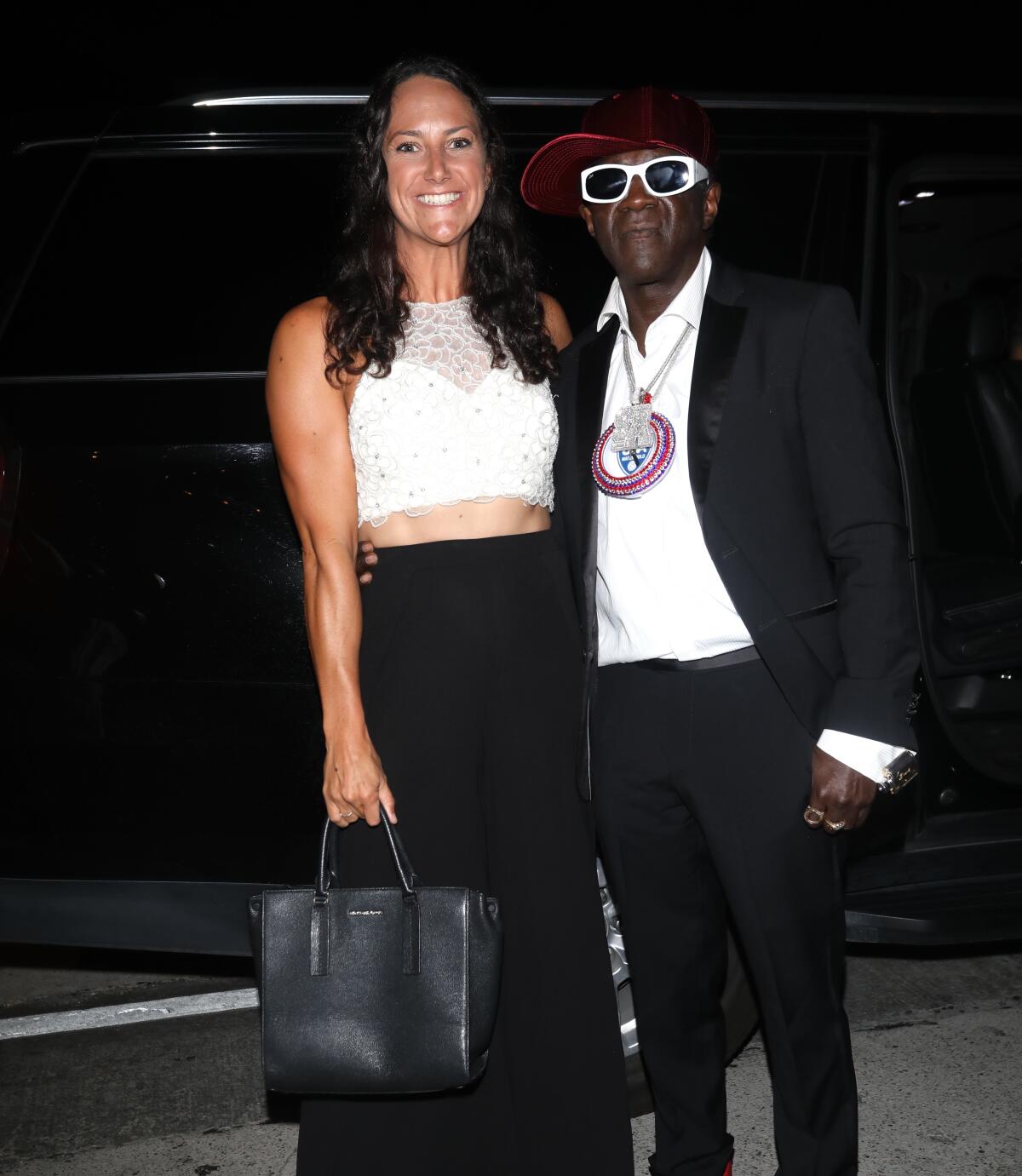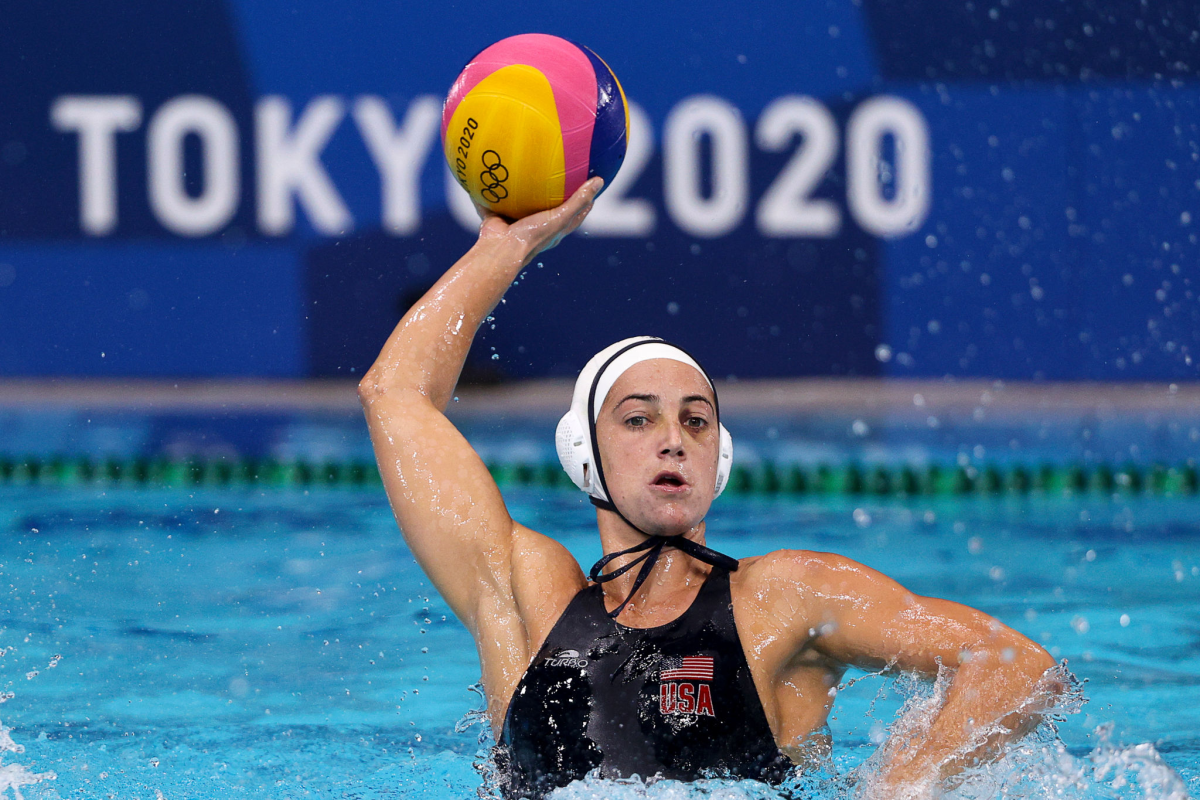Entertainment
Maggie Steffens wants to build U.S. water polo. That's where Flavor Flav comes in

Maggie Steffens is the greatest women’s water polo player of all time. And it’s really not close.
If she had been born in Hungary or Greece, countries where the sport is popular, her face might be plastered on magazine covers, billboards and cereal boxes. Instead she was born in California, where she and her Olympic teammates gave up any hope of fame or fortune the first time they jumped in the pool.
“Water polo is such a hard sport, you’re definitely not doing it for money. You’re definitely not doing it for being on a Wheaties box,” Steffens said. “You’re doing it for your dream. You’re doing it for your passion.”
Sure. But when you’ve won three gold medals, five world championships and are the leading scorer in Olympic history, it would be nice if people knew your name.
Maggie Steffens, left, celebrates after scoring for the U.S. against Hungary in the World Aquatics Championships in Doha, Qatar, in February.
(Lee Jin-man / Associated Press)
So ahead of the Paris Games, where the U.S. opens group play Saturday and chases a record fourth straight Olympic title, Steffens has enlisted the help of two diverse musical artists in Flavor Flav, the clock-wearing co-founder of the groundbreaking rap group Public Enemy, and Taylor Swift, perhaps the most popular entertainer on the planet, to raise the team’s profile.
The unlikely pairings surfaced in May after Steffens, the team captain, lauded her teammates’ talent and dedication in a heartfelt 388-word Instagram post that ended in a plea for support.
One of the first to respond was Flav, the Hall of Fame rapper. Earlier this month, he signed an unprecedented five-year deal to become the official “hype man” for the men’s and women’s national water polo teams. As part of the agreement, Flav, whose real name is William Drayton, will make an undisclosed financial contribution to the women’s team, appear at USA Water Polo events and leverage his massive social media presence to publicize the sport.
“I’m going to be the biggest hype man that they ever had in their life,” he told the Associated Press. “I’m going to be bigger than any cheerleader that they had in their life. I’m going to cheer this team into winning a gold medal.”

Maggie Steffens and Flavor Flav are seen on July 11 in Los Angeles.
(jfizzy / Star Max / GC Images)
Swift’s support for a self-described group of “talented and driven women” is totally on brand.
For Flav, a 65-year-old Black rap pioneer from Long Island, however, joining a team of blond-haired, blue-eyed “twenty-somethings” from California would appear to mix as well as oil and water polo.
That’s exactly the point, Steffens said.
Some players on the Olympic team have had to work multiple jobs to support their athletic careers. Introducing the game to people outside the sport’s narrow fan base could help increase support and make that unnecessary.
“If we just stay in that water polo community, how do we grow?” Steffens said. “What Flavor Flav has helped do is open up the door to the rest of the world and say, ‘Hey, check this sport out, check these women out.’
“That’s the chance that we need. Now our job is to be the women that we are and showcase what we can do.”
What they’ve done so far — three consecutive Olympic titles — had never been done before so a fourth gold in Paris would simply add to the record. For Steffens, every score in France will add to her Games record of 56 goals.
However, this competition could prove the most challenging for a team that has relied on age and experience. Seven of the 13 women on the Paris roster are first-time Olympians. With the Tokyo Games having been delayed a year by the COVID-19 pandemic, four years of preparation has been squeezed into three.
“There’s a lot of talk that we’re not as good as we’ve been in the past. I say it to the team all the time. And I mean it,” said coach Adam Krikorian, whose team was fifth in last year’s world championships, equaling its worst finish in a dozen years.
“I’m not trying to create motivation, it’s the reality. If you look at our roster and look at the horses that we lost, it was a big hit.”
It’s difficult to play polo without horses and among those who are no longer in Krikorian’s stable are three-time gold medalist Melissa Seideman; sisters Aria and Makenzie Fischer, who have four gold medals between them; four-time world and Olympic champion Alys Williams, and Stephania Haralabidis, who was third on the Tokyo team in scoring with 13 goals.
Among the replacements are defender Jordan Raney, the last player cut from the Tokyo roster, and defender Emily Ausmus, at 18 the youngest women’s water polo Olympian since Aria Fischer in 2016.
For Steffens, the journey from Tokyo to Paris has been the most difficult, mentally and physically, of her career. She underwent shoulder surgery after the last Olympics and, at 31, had to work her way back onto the roster for these Games.
If she had done that in search of a fourth straight gold medal in soccer or basketball, she’d be a household name. Instead she still has to flash her driver’s license to get into the team’s Los Alamitos training facility.
If she has any regrets, she keeps them well-hidden.
“Water polo has been my choice. Water polo has been my gift,” said Steffens, whose father played water polo in three Pan American Games for Puerto Rico and was a three-time All-American at California. “It’s my whole life so I would never trade that for the world.“

U.S. water polo player Maggie Steffens competes during the Tokyo Olympics.
(Getty Images)
Plus there are some fringe benefits, apart from the opportunity to collect more gold. That’s where Taylor Swift comes in.
Two months ago the team flew to Paris for an Olympic test event at the 5,000-seat Paris Aquatic Centre, where the group-stage matches will be played. What the players really wanted to do, however, was get a look at La Défense Arena, the spacious rugby stadium where water polo’s medal rounds will be held.
“The purpose was [to] see the venue and feel it and visualize ourselves there in a quarterfinal,” Steffens said.
Swift already had booked the stadium for her Eras Tour, so team manager Ally Beck reached out to the singer’s camp and asked if it would be OK to have a look around.
Swift did better than that, inviting the players and coaches backstage before a concert, then gifting them tickets in a special VIP area and outfitting them in tour jackets and T-shirts.
“They went beyond our wildest expectations,” Beck said.
The 3½-hour concert, Krikorian said, was more than entertaining. It was inspiring for a group of women who soon hope to be performing in that same building.
“I thought to myself, ‘This is exactly what we want to bring to the pool,’” the coach said. “What better way to get in the right mindset and to experience that energy and that joy and that love. Because those are the values that we want to play with.”
If they get the chance to show off those values in the Aug. 10 gold-medal final, Swift, who will be two hours away in Vienna, has an open invitation to come back and cheer the team.
“I’ll be on the record,” Krikorian said. “Taylor, you have a front-row seat.”
Right next to Flavor Flav.

Movie Reviews
403 Forbidden
Forbidden
Access to this resource on the server is denied!
Proudly powered by LiteSpeed Web Server
Please be advised that LiteSpeed Technologies Inc. is not a web hosting company and, as such, has no control over content found on this site.
Entertainment
Universal Music invests $80 million in Bollywood production company

Universal Music Group is investing $80 million for a stake in one of India’s biggest Bollywood production companies, Excel Entertainment Pvt.
Universal Music India, a division of Universal Music Group, will acquire a 30% equity interest in the Mumbai-based movie studio. In the deal, announced Monday, the companies will work together on forthcoming films, series, music and emerging formats.
While getting involved in India’s local film industry, Universal Music will also now receive global distribution rights for all future original soundtracks attached to projects produced or owned by Excel. There are also future plans for the companies to launch an Excel-linked music label that will allow UMG and Universal Music India artists to appear in various Excel titles.
The investment underscores the rapid growth in the Indian entertainment industry.
India is the 15th-largest recorded-music market globally.
Founded by producers Ritesh Sidhwani and Farhan Akhtar in 1999, Excel is responsible for making over 40 different films and scripted shows. Its most popular titles include “Dil Chahta Hai,” “Don” and “Talaash.” The company is currently valued at approximately $290 million.
“India’s entertainment landscape continues to grow from strength to strength, and this is the perfect moment to build meaningful global collaborations,” said Sidhwani and Akhtar in a joint statement. “Together, we aim to take culturally rooted stories to the world.”
Universal Music Group, with its corporate headquarters in the Netherlands and another office in Santa Monica, was founded in 1996. The music giant behind artists like Taylor Swift and Billie Eilish is valued at roughly $48 billion on the U.S. stock market, with shares selling around $25.80.
Movie Reviews
UNTIL DAWN Review

UNTIL DAWN is nicely shot and paced well, with believable performances. However, the movie has a strong humanist worldview featuring gruesome violence, lots of strong foul language, and excessive gore. The violence includes psychopathic killers, people spontaneously exploding, stabbings, kidnapping, demonic possession, and more. The frequent dying over and over in the plot of UNTIL DAWN puts the sanctity of life into question. It forces the characters to conduct abhorrent and unacceptable immoral actions for survival.
Dominant Worldview and Other Worldview Content/Elements:
Strong humanist worldview that twists the concept of modern psychology into a supernatural hellscape with unexplained time loops and reoccurring nightmarish horror filled with excessive violence and gore, but with unexplained pagan supernatural elements (such as a storm circling a house, the appearance of more buildings, the time loop itself, and many more), the time loop perverts the laws of mortality and implies that the consequences of violence, murder, suicide, etc., don’t apply, the psychologist controlling the time loop discusses the situation with modern psychology in vague circles meant to confuse and disorient the nature of the reality in which the victims are trapped, religion or God is not explicitly discussed, but there’s an unexplained cross in front of a house that isn’t explained and a character references the belief that a possessed person cannot become possessed through contact but rather weakness of faith, and some occult content where one woman is a self-described psychic and is into “woo-woo” stuff as another character describes it, she tries to amplify her psychic abilities with help from the others by holding hands and meditation, and she often has strong feelings and seems to have a sense the others do not have, but no worship or symbols are shown, plus a girl dating a guy is said to have previously dated a girl as well as other men;
Foul Language:
At least 101 obscenities (including 62 “f” words), two strong profanities mentioning the name of Jesus, and four light profanities;
Violence:
Very severe violence and gratuitous blood and gore throughout including but not limited to dead bodies, monsters, scarred masked psychopath, stabbing, beating, and people spontaneously exploding;
Sex:
No sex shown, but a person puts on a VHS tape and a pornographic movie is heard playing briefly but not shown, and a woman is said to date a lot of people and one time dated another woman;
Nudity:
No nudity;
Alcohol Use:
No alcohol use;
Smoking and/or Drug Use and Abuse:
No smoking or drugs; and,
Miscellaneous Immorality:
A psychologist is a callous antagonist whose motives are relatively unknown beyond having a morbid curiosity that led to awful experiments and playing games with other people, he purposely keeps people trapped for no known reason other than his sick and twisted observations that end in gruesome murder and unnecessary torture.
One year after her sister Melanie vanished without a trace, Clover and her friends look to find more information about her disappearance. Clues lead them to an abandoned mining town. This place of unimaginable horrors traps them all in a horrifying time loop where they will be murdered again and again.
UNTIL DAWN is nicely shot and paced well, with believable performances, but it has a strong humanist worldview overall with some occult elements is filled with gruesome violence, gore, lots of strong foul language, and a time loop that leads to an increasing amount of horrific murder and unacceptable immoral actions for survival.
The movie begins with a woman named Melanie clawing her way through the dirt with an unknown monster chasing after her. Digging her way out, she looks up to a masked psychopath standing over her with a scythe. She begs him, “No! Please not again. I can’t!” He fatally stabs her without a thought. It cuts to the main title, and an hourglass is shown with a ticking clock sound and unsettling music.
Cut to a group pf people in a red car driving up a winding mountain, an obvious nod to THE SHINING. It’s been one year after Clover’s sister Melanie vanished without a trace. The group consists of Max, Nina, Megan, Abe, and Clover. Shortly after their mother died, Melanie had decided to start a new life in New York. Clover decided to stay, which created tension between the sisters before Melanie left.
Clover and her friends are looking for more information about her disappearance. Their last stop is the last place she was seen in a video message taken in front of a middle-of-nowhere gas station. Megan, a proclaimed psychic, wants to join hands outside and see if they can feel any mystical energy regarding Melanie. Their attempt is cut short when an RV blares its horn and almost hits them, scaring them all.
Clover goes inside the gas station for a cup of coffee while the others talk outside. Clover asks the man behind the register if he worked here last year. After confirming he’s been working there for years, she shows him a picture of Melanie from the video. He asks if she was missing and clarifies saying that Clover is not the first to come asking. When she asks if many people around here go missing, he says people “get in trouble” in Glore Valley. As their only lead, the group decides to go there and stick together.
Nervously driving to the valley in an increasingly dangerous storm, the group begins to question what they are doing. Suddenly the storm stops but is still raging behind them. They park in front of a house with a “Welcome Center” sign, with the storm circling around the area but leaving the house dry. Confused, they get out of the car and look around. Nina decides to see if there’s anyone inside so they can come up with a plan. Everyone goes in except Clover, who walks up to the strange rain wall.
Inside the house, they find a dated and dusty interior. The power and water don’t work, and they conclude that they are the first people to come there in years. There is a strange hourglass with a skull on the wall. Checking the guest book, Nina finds Melanie’s name signed multiple times, with increasingly shaky handwriting. In another room, Abe finds many missing posters with faces on a bulletin board and finds poster with Melanie’s face.
Outside, Clover thinks she sees a person in the rain. She also hears Melanie’s voice and runs after it. Concerned, Max calls after her and he pulls her back in. As Nina signs the guestbook, the sun suddenly sets and the clock starts ticking.
Inside the house now with the hourglass turned over, they try to understand what’s happening. The car is out in the rain now with someone revving the engine threateningly. Some of them go to the dark basement, where the lights don’t work. There is an eerie sense of dread as Abe goes to check out a noise, and Nina finds a scarred and masked psychopath standing in a room as the top half of Abe’s body falls to the ground.
Hearing the commotion upstairs, the others go to see what happened and Max spots the killer. They run to hide, and the apparently invincible psychopath horrifically stabs each of them as they try to fight back. The sand in the hourglass runs back, as each character returns to where they were when Nina originally signed the book (she now signs it a second time). They remember what had just taken place, and how they were all murdered. Clearly stuck in this time loop escape room situation, they will now have to figure out how to escape this terrifying hellscape as the situations get worse with every loop.
UNTIL DAWN is nicely shot and paced well, with believable performances. However, the movie has a strong humanist worldview featuring gruesome violence, lots of strong foul language, and excessive gore. The violence includes psychopathic killers, people spontaneously exploding, stabbings, kidnapping, demonic possession, and more. The frequent dying over and over in the plot puts the sanctity of life into question. It forces the characters to conduct abhorrent and unacceptable immoral actions for survival.
-

 World1 week ago
World1 week agoHamas builds new terror regime in Gaza, recruiting teens amid problematic election
-

 Indianapolis, IN1 week ago
Indianapolis, IN1 week agoIndianapolis Colts playoffs: Updated elimination scenario, AFC standings, playoff picture for Week 17
-

 News1 week ago
News1 week agoFor those who help the poor, 2025 goes down as a year of chaos
-

 World1 week ago
World1 week agoPodcast: The 2025 EU-US relationship explained simply
-

 Business1 week ago
Business1 week agoInstacart ends AI pricing test that charged shoppers different prices for the same items
-

 Business1 week ago
Business1 week agoApple, Google and others tell some foreign employees to avoid traveling out of the country
-

 Politics1 week ago
Politics1 week ago‘Unlucky’ Honduran woman arrested after allegedly running red light and crashing into ICE vehicle
-

 Technology1 week ago
Technology1 week agoChatGPT’s GPT-5.2 is here, and it feels rushed
















